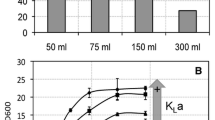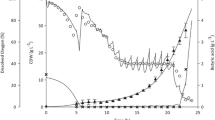Abstract
The requirement and supply of reducing power and ATP for the growth-associated synthesis of polyhydroxybutyrate (PHB) and the non-PHB biomass were balanced. By using glycerol, glucose, fructose, octanoate or oleate, the net balances of the PHB synthesizes result in an energy surplus which might contribute to growth. The calculated yields amount up to 90% PHB in cells correlating inversely to the P/O-quotient. The growth-associated PHB production contributes to two metabolic processes: supplying energy for growth and accumulating storage material.
Similar content being viewed by others

References
Ackermann JU, Müller S, Lösche A, Bley T, Babel W (1995) Methylobacterium rhodesianum cells tend to double the DNA content under growth limitations and accumulate PHB. J. Biotechnol. 39: 9–20.
Anderson AJ, Dawes EA (1990) Occurrence, metabolism, metabolic role, and industrial uses of bacterial polyhydroxyalkanoates. Microbiol. Rev. 54: 450–472.
Babel W (1994) Bioremediation of ecosystems by microorganism. Approaches for exploiting upper limits and widening bottlenecks. Bioremediation. The Tokyo '94 Workshop. OEDCDocuments, pp. 101–108
Babel W, Müller RH (1985) The influence of carbon catabolism on the auxiliary substrate effect. Acta Biotechnol. 5: 333–338.
Choi JL, Lee YL (1999) High level production of poly(3-hydroxybutyrate-co-hydroxyvalerate) by fed-batch culture of recombinant Escherichia coli. Appl. Eur. Microbiol. 65: 4363–4368.
Encarnacion S, Dunn M, Willms K, Mora J (1995) Fermentative andaerobic metabolism in Rhizobium etli. J. Bacteriol. 177: 3058–3066.
Föllner CG, Ackermann JU, Babel W (1997) Which is the reducing power generator in methylotrophs for the synthesis of poly(3-hydroxybutyric acid? (Poster4/14). In: Eggink G, ed. International Symposium on Bacterial Polyhydroxyalkanoates. Davos: ISBN 0–660–17083–3.
Hänggi UJ (1995) Requirements of bacterial polyesters as future substitute for conventional plastics for consumers good. FEMS Microbiol. Rev. 16: 213–220.
Huijberts GNM, Eggink B (1996) Production of poly(3-hydroxyalkanoates) by Pseudomonas putida KT 2442. Appl. Microbiol. Biotechnol. 46: 233–239.
Kim BS, Chang HN (1998) Production of poly/3-hydroxybutyrate) from starch by Azotobacter chroococcum. Biotechnol. Lett. 20: 109–112.
Kleber HP, Schlee D (1991) Biochemie. Teil 1 -Allgemeine und funktionelle Biochemie, 2th edn.Jena: Gustav Fischer.
Leaf TA, Srienc F (1998) Metabolic modelling of polyhydroxybutyrate biosynthesis. Biotechnol. Bioeng. 57: 557–570.
Lee SY (1996) Plastic bacteria? Progress and prospects for polyhydroxyalkanoate production in bacteria. Trends Biotechnol. 14: 431–438.
Lee SY, Chang HN (1995) Production of poly(hydroxybutyric acid) by recombinant Escherichia coli strains. Can. J. Microbiol. 41 (Suppl. 1): 207–215.
Moser A (1981) Bioprozeßtechnik. Wien, New York: Springer-Verlag.
Page WJ, Manchak J, Rudy B (1992) Formation of poly(hydroxybutyrate-co-hydroxyvalerate) by Azotobacter vinelandii UWD. Appl. Environ. Microbiol. 58: 2866–2873.
Park JS, Park HC, Huh TL, Lee YH (1995) Production of polyhydroxybutyrate by Alkaligenes eutrophus transformants harbouring cloned phb CAB genes. Biotechnol. Lett. 17: 735–740.
Son H, Park G, Lee S (1996) Growth-associated production of poly-β-hydroxybutyrate from glucose or alcoholic distillery wastewaterby Acinetobacillus sp. EL 9. Biotechnol. Lett. 18: 1229–1234.
Wang F, Lee SY (1998) High cell density culture of metabolically engineered Escherichia coli for the production of poly(3-hydroxybutyrate) in a defined medium. Biotechnol. Bioeng. 58: 325–328.
Yamane T (1993) Yield of poly-D-(-)-3-hydroxybutyrate from various carbon sources: a theoretical study. Biotechnol. Bioeng. 41: 165–170.
Zinn M, Egli T, Witholt B (1997) Application of a transient feed technique in continuous culture to detect double nutrient limited growth of Pseudomonas oleovorans (Poster4/08). In: Eggink G, ed. International Symposium on Bacterial Polyhydroxyalkanoates. Davos: ISBN 0–660–17083–3.
Zlotnikov K, Sanchevich N, Kadomceva V, Zlotnikov A, Akimenko V (1997) Potentials of Bacillus megatherium for industrial production of PHAs (Poster 8/01). In: Eggink G, ed. International Symposium on Bacterial Polyhydroxyalkanoates. Davos: ISBN 0–660–17083–3.
Author information
Authors and Affiliations
Rights and permissions
About this article
Cite this article
Bormann, EJ. Stoichiometrically calculated yields of the growth-associated production of polyhydroxybutyrate in bacteria. Biotechnology Letters 22, 1437–1442 (2000). https://doi.org/10.1023/A:1005602900090
Issue Date:
DOI: https://doi.org/10.1023/A:1005602900090



